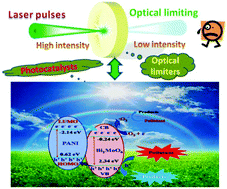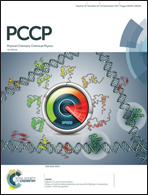Polyaniline decorated Bi2MoO6 nanosheets with effective interfacial charge transfer as photocatalysts and optical limiters†
Abstract
Polyaniline (PANI)-decorated Bi2MoO6 nanosheets (BMO/PANI) were prepared by a facile solvothermal method. Different characterization techniques, including X-ray powder diffraction, scanning electron microscopy, transmission electron microscopy, Raman spectroscopy, Fourier transform infrared spectroscopy, X-ray photoelectron spectroscopy, diffuse reflectance ultraviolet-visible spectroscopy, photoluminescence spectroscopy, electrochemical impedance spectroscopy, photocurrent spectroscopy, and nanosecond time-resolved emission studies, have been employed to investigate the structure, optical and electrical properties of the BMO/PANI composites. The wide absorption of the samples in the visible light region makes them suitable for nonlinear transmission and photocatalytic activity studies. The associated photocatalytic activity and optical nonlinearities for the BMO/PANI composites are shown to be dependent on the PANI loadings. The rational mechanisms responsible for deteriorating pollutants and improving optical nonlinearities were also proposed, which could be mainly attributed to the efficient interfacial charge transfer and the interfacial electronic interactions between PANI and Bi2MoO6. The photoluminescence spectroscopy, electrochemical impedance spectroscopy, and photocurrent spectroscopy studies confirmed that the interface charge separation efficiency was greatly improved by coupling Bi2MoO6 with PANI. The tuning of photocatalysis and nonlinear optical behaviors with variation in the content of PANI provides an easy way to attain tunable properties, which are exceedingly required in optoelectronics applications.



 Please wait while we load your content...
Please wait while we load your content...